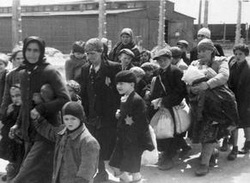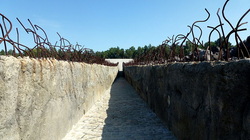 By Walter Reich New York Times, June 12, 2004 After my uncles, aunts, cousins and, probably, grandmother were gassed in 1942 in Belzec, a German death camp in Poland, their remains were dumped into mass graves there, together with those of at least 500,000 other Jews.  That small site, about 15 acres, is one of the most concentrated zones of death in the world. In the past 15 years I've gone to Belzec five times to visit those remains and say Kaddish for the dead. Now a trench, about 30 feet deep and open at both ends, has been dug into the ground between the mass graves. Stretching through the heart of the camp, it's the central element of a memorial that was unveiled last week. The trench lets people not only visit the remains of the dead but go deep into the earth and walk among them. Some have argued that after years of increasing exposure to Holocaust museums and movies, the public has developed ''Holocaust fatigue''; the trench would intensify the experience, making visitors feel, as the victims felt, trapped and doomed. This is, for me, a stupefying idea. One visits a grave site; one doesn't invade it. But that is what the memorial has done. In the digging of the trench, the surface soil, much of it ash and bone, was disturbed. Workers discarded some of the human remains. And the greatest invasion is yet to come. Tourists will pass through the trench. Some will be moved. Others, like schoolchildren on class trips, will be noisy. And they'll be walking between mass graves containing the incinerated remains of tens of thousands of people. In their last moments, those dead were tortured beyond anything we can imagine. Transported from ghettos in cattle cars, they were forced, once at Belzec, to undress. They were then chased through a narrow passage between barbed wire, past a gantlet of screaming guards with whips, who herded them into the gas chambers. And after the carbon monoxide? One SS officer described a gassing of 3,000 Jews in 1942. The dead, he recalled, stood ''erect like basalt columns, for there is no room to fall or to collapse,'' adding: ''Even in death, one can recognize the families, holding hands. It is only with difficulty that they can be separated to make room in the chambers for the next transport.'' Neither those 3,000 nor the other hundreds of thousands of Holocaust dead in Belzec needed this trench. A strong fence should have been built around the site to keep everyone out. A memorial structure, bearing a sign explaining what happened in Belzec, should have been erected nearby. And the dead should have been left undisturbed, forever. But the deed is done. The trench is open. Tourists will surge through it. And I'll continue to visit, standing outside, saying Kaddish for those tortured dead. Walter Reich, a professor of international affairs at George Washington University, was the director of the United States Holocaust Memorial Museum from 1995 to 1998. Comments are closed.
|
CISA Blog
This blog provides selective critical analysis on developments in contemporary culture related to the subjects of antisemitism, racism, the Holocaust, genocide, and human rights.
|
© 2025 Canadian Institute for the Study of Antisemitism. All Rights Reserved.
 RSS Feed
RSS Feed